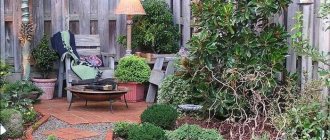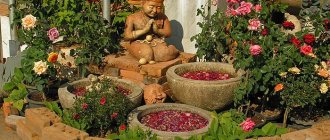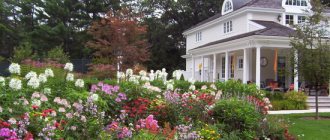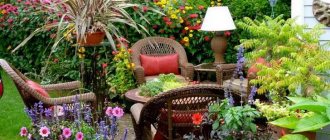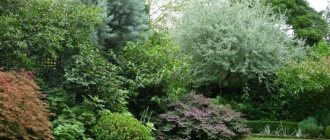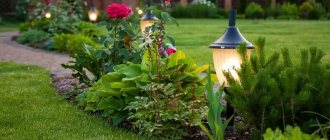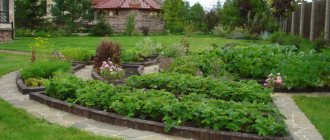Japan is a country with unusual traditions and original culture. One can talk for hours about the ceremonies and customs of this great people. Nothing is created here just like that; every creation, be it simple origami or ikebana, has a whole backstory of its appearance and necessarily its own philosophy of execution. Man is designed in such a way that his attention is attracted by everything unusual, which is why Japanese motifs quickly and firmly established themselves in American and European interiors. And if the internal delights are not always accessible to view, then the Japanese-style garden, laid out in the open space of the estate, will not allow you to pass by without looking at its peaceful beauty. Sometimes it can be difficult to cope with the desire to push the gate, sit down on a stone bench and immerse yourself in thoughts about the eternal.
The history of the origin of the Japanese garden
The formation of the Japanese garden style began in the distant X-XI centuries and lasted for almost five hundred years. During this period, certain canons were developed, which landscape designers still adhere to today. Since Japan is located in a difficult climatic zone and has a difficult terrain, the gardens turned out to be very unusual. The fact is that their basis is not trees at all, as many imagine, but... stones. Plants were added to its territory in minimal quantities or were completely dispensed with. The Japanese-style gardens laid out in front of the Mikado Palace and in the country's ancient monasteries can be called a real work of art . The breath of eras is felt in their space. When Europeans were lucky enough to see these unusual creations for the first time, they really wanted to recreate something similar in their homeland. For this purpose, Japanese craftsmen were initially hired and no expense was spared on the delivery of original materials. Today, such landscapes are no longer a curiosity and can only cause genuine delight due to the originality of their execution.
Bonsai forms - styles
The styles that define the basis of bonsai classification resemble the forms of trees in the surrounding nature. Thanks to an individual creative approach, they can transform.
Bonsai created by nature itself
Fan style (hokidachi)
The fan style, also known as broom, is relevant for deciduous representatives of woody plants. The basic principle of the style is upright. The woody stem is always erect and vertical, but does not reach the crown of the tree, branching in different directions. It is located at a distance of ⅓ from the total height of the plant. Numerous branches and a small trunk, reminiscent of a graphic design, look impressive even during leaf fall. Elm or maple are better suited as the basis for the embodiment of such a tree.
The most commonly used material for fan style is Japanese red maple.
Formal vertical style (tekkan)
A characteristic feature of one of the most common styles is a gradual narrowing of the diameter of the trunk from the base to the crown. This form of trees is often found in sunny growing conditions, where excess light eliminates competition with other plants. The branch should appear at a distance of ¼ of the entire height of the tree. The simplest and most clearly defined lines create a primary and important form that every bonsai lover should be familiar with.
The formal vertical style is quite common in bonsai.
Informal vertical style (moegi)
The popular style is characterized by a curved vertical line of the trunk and a clearly defined break at the base. Ideally, the number of bends does not exceed three, with the same angle of inclination relative to each other.
Externally, the tree trunk should resemble the English letter S
Main features of the style:
- curved trunk with good slope;
- the location of the base of the tree and its crown on the same vertical with a strict upward direction;
- the ratio of bare trunk to shape is ¼.
Coniferous (juniper, pine) and deciduous species (maple, oak) are better suited for this style.
A tree with sparsely located branches on the bends of the trunk looks attractive.
Oblique bonsai style (shakan)
The style design assumes the tree grows at an angle of 60-80°. The trunk can be narrow or thick, straight or curved, with branches growing in two directions. The effect of a tree torn up by the wind is enhanced by roots peeking out from the ground. To visually balance the composition, the first branch should grow in the direction opposite to the slope.
Under natural conditions, this form of tree can occur if the winds blow predominantly in one direction or when the plant is forced to stretch from the shade to the sun
Cascade style (kengai)
In nature, a tree can bend under the weight of snow, stones or other factors. It is not easy to maintain this direction in an artificial design. As a rule, the cascade style involves planting trees in tall pots.
The main branch of a plant grown in a cascade style should fall below the bottom of the pot
When grown in open ground, a semi-cascade style is used, in which the last cascade should not fall below the root system of the plant
Character traits:
- the base is vertical with a gradual bend upward;
- growth direction - towards the plane of the earth;
- the crown is located above the edges of the container, the remaining branches grow in an alternating order on the left and right on the outer bends of the cascading trunk;
- The location of the branches is vertical to ensure a balanced composition.
To implement this style concept, naturally plastic plants, for example, juniper, are chosen.
Garden bonsai from Cossack juniper
Tree bent by the wind (fukinagashi)
The main concept of style is the struggle for existence. The trunk and branches grow in the dominant direction of the winds. Branches can grow along the entire diameter of the trunk, but the end result is that they all bend in one direction. One side of the bonsai may be left without foliage. This creates the illusion that the composition is tilted by gusts of wind.
Fukinagashi is a tree with sinuously inclined trunks
Dead wood style (sharimiki)
The style design involves the formation of a composition exposed to harsh weather. A characteristic feature is the formation of bare areas without bark, starting from the base of the trunk and spreading along its entire length. In artificial garden bonsai, this effect is achieved by removing the bark with a sharp knife. Subsequently, the exposed wood is treated with sulfurous lime.
In the Syarimiki style, the absence of bark on the tree is important, and the shape of the trunk itself is not particularly important
The list of styles is quite wide. Also distinguished are the style Tree on a stone, Roots on a rock, Grove or group planting, Multi-trunk, Double trunk, Literary, etc.
Double trunk style Open root style
Style roots on a rock
Literary style
Multi-barrel style
Grove style
Japanese style garden concept
The main feature of the Japanese garden style is the deep internal harmony generated by unity with nature. When creating such a landscape, you should not strive for symmetry, because it serves as a sign of unnaturalness and demonstrates the influence on human nature. The main elements used in the design are:
- Stones.
- Water.
- Plants.
When laying out a garden, it is very important to maintain the harmony of the elements. Japanese masters consider stones to be the skeleton of the garden, and water to be its blood. They prefer to give the composition a complete look by making extensive use of secondary elements, the list of which includes:
- Bamboo fences.
- Bridges.
- Gazebos.
- Lanterns.
- Gates.
- Bells.
These small architectural forms often play the role of zest and bring real comfort to the overall atmosphere. In our climate, it is rational to saturate the landscape with a large number of plants characteristic of a particular natural zone, because Asian exotics simply do not survive in the temperate zone. When creating reservoirs, they try to avoid making them of the correct shape. Their outlines always have smooth and, most importantly, natural curves. Only in this case will they be able to convey the energy of calm and tranquility. Pretentious fountains in a garden laid out in the Japanese style should be replaced with small waterfalls, but if there is an irresistible desire to decorate it with a fountain, then in no case should it be pretentious, otherwise the idyll of naturalness will be violated . In gardens of modest size, large elements in the form of stone blocks, enormous trees and massive benches are not used. Such a design will not tolerate a riot of colors. In the Japanese style, green color predominates, and the rest of the spectrum can only be present in the form of small dotted inclusions in a minimal volume.
Tips for landscaping gardens
If a person has decided to arrange something like a Japanese garden on his property, then he can take note of a few tips:
- The best terrain for a Japanese-style corner will be a slight slope or a narrow rather than wide strip of land. All compositions will look more advantageous there.
- You can lengthen the path along the site using winding paths. This solution will allow you to enjoy your walk longer and better view the compositions you encounter.
- When planning and arranging stones, lanterns, and planting plants, you need to use the technique of asymmetry. It will make the garden look as natural as possible.
- In order not to give the garden a chaotic look, you should not fill it with a large number of architectural forms and boulders.
- Monogardens look great in Japanese-style landscape design. These are compositions that include plants and stones of 1 color (for example, white, brown) or type (a garden consisting only of mosses).
- To make a corner of nature look natural, you should not overload it with Japanese components. It is better to take some of them, for example, lanterns and a pond or a dry rock garden framed by green hostas.
Depending on the size of the dacha area, the preferences and fantasies of the owners, you can arrange a cozy refuge from worries and worries to your liking. Walking along the winding paths of the amazing Japanese garden and enjoying its beauty and tranquility, you can once again realize the greatness of nature and feel unity with it.
Music of Japanese garden stones
In the traditional interpretation, the stones are laid out diagonally, starting from the left corner of the allocated area
The Japanese garden is often called the Rock Garden, because it is these natural elements that form its structure and remind people of strength and perseverance. Composing them into a composition is a difficult art. In the traditional interpretation, the stones are laid out diagonally, starting from the left corner of the allocated area. The number of stones used must be odd. The composition certainly uses raw stones of various shades. Over the years, they will become overgrown with moss and blend even more harmoniously with the natural landscape. It is customary to plant plants around stones. A Japanese-style garden composition may contain groups of stones, where boulders are mixed with small elements. Sculptures made of polished and painted stone will fit well into the structure of the garden. But, perhaps, the most favorite part of such a garden will be the winding paths made of assorted stones, because walking along them is an indescribable pleasure.
Features of the Asian garden landscape
What is the currently popular destination of the Land of the Rising Sun? Before you create a beautiful natural corner at your dacha or near a cottage, you should know the features of this style. The landscape of a Japanese garden includes 5 mandatory elements. The first of these, according to Asian philosophy, is spiritual. It contains the basic concept of the future landscape. The remaining 4 elements are material. These include:
- water;
- trees, grass, flowers;
- stones;
- architectural forms.
To properly design a Japanese garden, you need all these components. It is then that the composition will acquire true beauty and harmony, the genuine spirit of Japan. The landscapes of this country fascinate with their beauty. There are many mountains on its territory, there are lakes and winding rivers, amazing plants.
The Japanese allowed 3 elements into their gardens: air, water and earth. This is the best that their native nature gives them.
Residents of the Land of the Rising Sun filled wonderful corners with symbolism, connecting it with the elements. Thus, they associate stones with mountains, with man’s desire for heaven, perfection, and the gods. They serve as a symbol of perseverance and strength. Water is a moving element; the Japanese have long considered it a symbol of life and surging energy. And the color scheme of the flora can pacify a person, show him the flow of life through plants replacing one another.
Air, water and earth - 3 elements of the Japanese garden
Japanese landscape design provides several types of landscapes. So there are gardens that have real water. It can be seen in ponds, streams, waterfalls. The layout of areas with imitation of the water element is also very popular. These are the so-called dry gardens. In them, water is replaced by white gravel, on which wave lines are drawn with a special rake. Typically, stones are placed on the surface of such a gravel platform. It seems that this is the Sea of Japan with rocks sticking out from under the water.
Dry ponds or streams lined with smaller pebbles are also very popular.
In all garden landscapes, the presence of plants and artificially created objects is mandatory. What are the requirements for the material elements of Asian landscapes?
Life-giving energy of water
It is impossible to create a Japanese garden without such an attribute as water. Only fountains and ponds, waterfalls and streams can fill the space with movement and volume. A bridge is certainly built over the surface of the water. Don’t be discouraged if conditions do not allow you to set up even the simplest alpine slide. The absence of a lake will perfectly replace a dry stream. Its formed bed is laid out with smooth pebbles with glitter or gravel, and if the accents are correctly distributed, a real feeling of the presence of water is created. Water-loving plants planted along the banks will help add more naturalness to the landscape.
Plants for the Japanese garden
The selection of plants for a Japanese-style garden is carried out according to the wave principle. This means that in any season there should be something to admire in such a landscape. In the warm season, one fading group of plants should immediately be replaced by a new blooming area. Since the essence of a Japanese garden is to recreate the world in miniature, its landscape cannot do without low-growing plants such as juniper, rhododendron, dwarf spruce, and Karelian birch. They are combined with powerful giants - elms, oaks, and pines. You can fill the space with fruit trees, which will give incredible aesthetic pleasure during flowering time. Apricots, cherries, plums with the beauty of their flowers are quite capable of replacing Japanese sakura. As for herbaceous plants, large-leaved species will look more advantageous in a Japanese garden. It can be:
- Fern.
- Host.
- Rogersia.
- Chrysanthemums.
You can’t ignore traditional Asian bamboo and bonsai. Moreover, the latter can be integrated into the design directly in the pots.
What plants are suitable for an Asian landscape?
In the landscape design of a Japanese garden, it is customary to use restrained and muted colors. There is almost no place for bright and flashy colors, because the whole philosophy of the landscape should pacify a person, and not irritate him. Experienced designers recommend using calm shades of green, brown, gray and white in Asian style design. Therefore, people who want to create a real corner of Japan in their dacha should choose the right plants for it. The most common color is green. To introduce it into the panorama of the garden, it is necessary to plant coniferous trees of various species there: junipers, cypresses, pines, which are a symbol of longevity, and thujas. From deciduous trees you can choose Tatarian maple, cherry, and ornamental apple tree. It is worth paying attention to the evergreen azalea or magnolia. If a person plans to plant shrubs in the garden, then it is necessary to choose Japanese quince, black alder, Canadian, and Japanese rhododendron. Bonsais will look great on the site.
Bonsai
The best choice among perennials would be astilbes, ferns, lilies of the valley, hostas and various types of cereals. Flowering plants include irises and daylilies. If people live in warm regions, you can plant bamboo. In other cases, you can use its trunks for decorative purposes: make a gate, a pergola out of them, decorate a hedge or a flower arrangement. The photograph makes it possible to see the entrance gate to the garden, made from this exotic representative of the flora.
Bamboo gate to the garden
With the right plants, you can enjoy changing landscapes at every time of the year. The landscapes of the spring garden will delight owners with pink and white dresses of sakura, azaleas and cherries. In summer, the eye will rest on greenery of various shades, and in autumn, the red foliage of maples will lift your spirits. Thanks to the presence of 1-2 bright colors in the garden, it will look festive and fresh every season. But don’t overuse bright colors. Everything should be in moderation.
Decorative romance of the garden
The best decorative elements of a garden decorated in Japanese style will be stone sculptures and miniature pagodas made of stone or wood . Along the alleys you can place low lanterns and neat stone benches. Hang iridescent bells on the trees, perfectly repeating the song of the wind and instilling peace. The main thing is not to overdo it with man-made materials, otherwise the garden will lose its semantic meaning.
Color solutions
All elements of the garden should be done in muted colors; bright colors are created only when plants are in flower. The most common colors used are soft shades of white, gray or brown.
The simplest option for creating a common palette is to plant abundantly planting vegetation, which will set the overall green background. Subsequently, it can be diluted with gray inclusions of stones, a wooden gazebo, and various small decorative elements. A distinctive feature of the Japanese garden is that, due to evergreen plants, it practically does not change its appearance at different times of the year.
Bridges in Japanese philosophy
For most of us, a bridge is a structure designed to move over an obstacle. In gardens created in the Japanese style, this is only a decorative element that carries a semantic load. In this landscape, bridges symbolize the path of life. According to custom, they are made of valuable wood, distinguished by its bright color. Such bridges can be decorated with stones, randomly placing them along a curved path. A path of small, oblong stones leading to the bridge will make its presence even more organic. On the sides of such an alley, it is advisable to plant numerous small flower beds. Standing on such a bridge, it is impossible to resist thinking about the meaning of life.
Relief variety of Japanese gardens
It is not a problem to equip spacious areas for the samurai philosophy. There's plenty of room to roam around there. But is it really possible to create a modern summer cottage design in this style? Quite! Professional designers can create a modest Japanese-style garden in flat and hilly versions. To create planar compositions you will need sand, small stones and moss. Reanlzi's garden is designed in this manner. Sand processed by a rake symbolizes sea waves and an immense water area, along the perimeter of which moss is randomly laid out and stones are scattered chaotically. In hilly terrain, greenery may not be used. A good landscape will be created by mountains, sand, pebbles and structural stones - the main thing here is to arrange everything correctly. An elongated boulder when installed vertically will symbolize a mountain peak, and flat cobblestones paved around will symbolize its slopes. Pebbles and sand are used to create the illusion of a body of water.
Types of design
Japanese style in landscape design is represented by 4 options for implementing the direction:
- Tsubo is a small area of a yard or building with an open roof.
- A rock garden is a space without vegetation. It is quite easy to decorate, but may not be decorative enough.
- The tree garden is a kind of park area, which is characterized by maximum naturalness and changes according to the seasons.
- A tea garden is a combination of two types of vegetation with different designs. In shaded areas, a special pavilion must be set up for traditional tea ceremonies.
Tsubo
This garden dates back to the Middle Ages, when the architecture of Japanese cities was just developing. The name comes from the word “tsubo”, which means a small area of about 3 m2. The composition can be placed both indoors and within the main landscape.
A small piece of nature is designed to enliven urban housing and decorate cramped spaces. Plants are planted according to the cardinal direction. It is better to decorate the northern areas with various mosses, since they are not suitable for heat-loving plantings.
The main space of the tsubo is occupied by stones, leaving a tiny area for vegetation. The center of the composition is made up of trees, which are selected to match the overall design of the home. A similar garden can be arranged in a country house - all you need to do is install a tsukubai lantern, lay stone paths and plant a small number of plants.
You can enhance the lighting with the help of lamps, lanterns and mirror surfaces. Thus, the space will acquire a special oriental atmosphere of warmth and harmony.
House with tsubo Source web-sad.ru
Music of Japanese garden stones
In Eastern philosophy, stones symbolize stability and vitality. Placers of cobblestones are a reflection of the vast, endless Universe, which cannot be quickly known and studied. Stones must be placed in the garden in such a way that only a few of them are visible from any point in the area. The quantity must be an odd number.
Stones in a Japanese garden Source dobrostroy.house
The stones in the composition are always laid diagonally from the left corner of the accessible area. The colors of the cobblestones should be similar; you can create groups of different shades. The only condition is that the stones cannot be processed, they remain in their natural form. Over time, natural objects will become covered with moss, which will give them a more natural and attractive appearance. The size of the stones does not matter; you can alternate between small stones and massive boulders. Among the composition, trees with bright leaves and unusual shrubs will look great.
Compositions made of stones Source diz-cafe.com
Japanese landscape design creates a calm, peaceful atmosphere that is filled with harmony and provides excellent opportunities for contemplation and reflection. Winding stone paths invite the visitor to wander among untouched nature and enjoy the natural beauty of plants. Paths can be very different - paved with flat stones with a smooth surface, which symbolize the path of life without obstacles, or paths made of gravel, sandstone or pebbles. These materials can replace water bodies; dry streams or small waterfalls are created from them.
Stream of stones Source roomester.ru
Objects in the garden are placed according to strict rules, violation of which threatens the loss of harmony. The main stone is located in the center of the composition, and the remaining elements complement the design and symbolize the features of the relief. Cobblestones can be designed in the form of islands or mountain systems, it all depends on the designer’s imagination.
The stones should not be placed in strict sequence, since symmetry is not welcome here. Objects from rivers, mountains and seas do not combine in one area. To ensure a stable position of the cobblestones, you can dig them in a little. To disguise the flaws of boulders, small shrubs and herbaceous plants are planted next to them. They should be wild and inexpressive shades.
Plants near a pond made of stones Source greenhome.kz
Features of landscape lighting
You can understand the essence of the art of creating a Japanese-style garden only by immersing yourself in its atmosphere
A Japanese-style garden will never be logically complete if it does not have thoughtful lighting. In large gardens, tachi gata is certainly used. These lanterns range in height from one and a half to three meters and can illuminate large areas. Near Tsukubai you can often find hidden lanterns - ikekomi-gata. Their light is directed downward, which helps maintain an atmosphere of twilight and mystery. The outline of the ponds is marked with tiny oki-gata, and yakimi-gata can be installed near other bodies of water.
You can understand the essence of the art of creating a Japanese-style garden only by immersing yourself in its atmosphere. In Russia, this can be done in the Main Botanical Garden. The corner of Japan here was reproduced in 1987, is considered a type of tea garden and has a special atmosphere that is pleasant to plunge into in any season. Walking along it, a person spiritually prepares for the tea ceremony.
Japanese style garden
Stages of creation
To independently create a stone garden, popular among the residents of Japan and our compatriots, you need to decide on its location.
It is necessary that this area has good soil and sunlight, plus natural ventilation. If you are planning a pond or other water feature in the garden, start by creating its configuration. The pond should look realistic: give up the square shape and other fancy formats that you won’t find in the natural environment. This rule also applies to artificial streams created.
Having prepared the trenches and designed the water sources, you can move on to other components of the landscape design. Choose vegetation that fits best with the Japanese design. Study the features of flowering and growing plants - ornamental shrubs and trees: keep in mind that annuals will have to be replanted for the next season, and flowers that love warmth will no longer decorate the area in the cold season.
Having finished planting the vegetation, move on to the stone elements. Avoid stones that differ dramatically in color, configuration and size. Replace the abundance of small stones with two or three large boulders. Such elements can be used as the main ones in the design, and with the help of small ones you can decorate the surrounding space. This technique will allow you to focus attention on volumetric shapes.
Recommendation: to make your garden look natural, do not bury stones in the soil.
The largest boulder can be placed in the central area of the garden, and small elements can be used to decorate the space around it. Such design will be associated with the Buddhist triad. It is better to concentrate stone details in the area where there is an artificially created water source, along the bank of a stream or in separate places around the perimeter of the pond.
Creating the design of a Japanese garden on your own on a plot near a private house will give you great pleasure and will help you find spiritual harmony, and the final result will bring aesthetic satisfaction. This garden is ideal for spending time outdoors: reading, doing meditative exercises and just relaxing.
